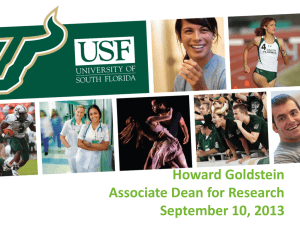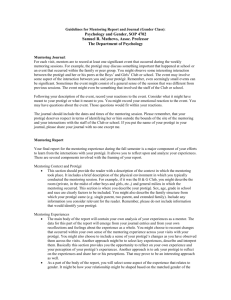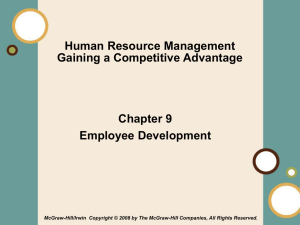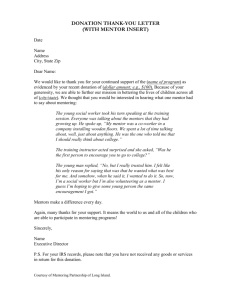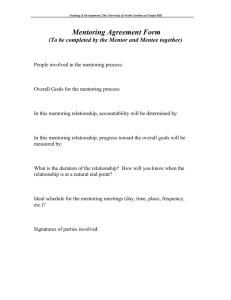Advancing in Your Career Through Mentoring
advertisement
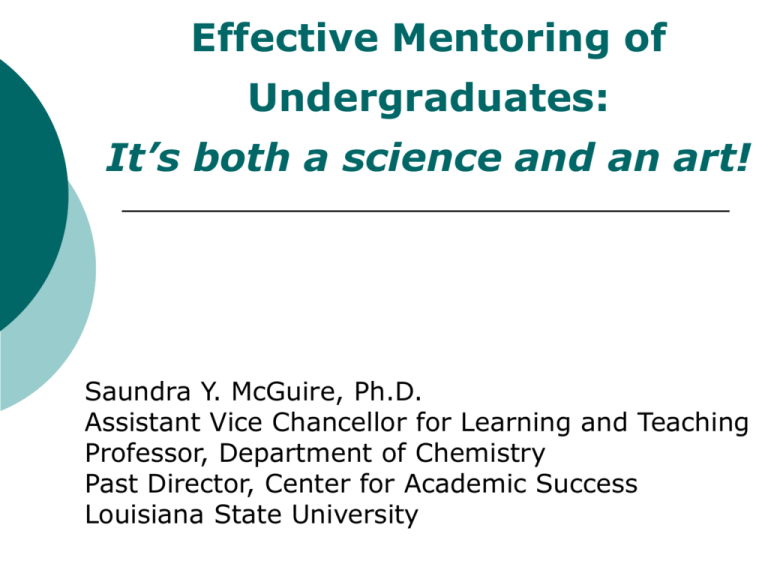
Effective Mentoring of Undergraduates: It’s both a science and an art! Saundra Y. McGuire, Ph.D. Assistant Vice Chancellor for Learning and Teaching Professor, Department of Chemistry Past Director, Center for Academic Success Louisiana State University The Center for Academic Success 2004 National College Learning Center Association Frank L. Christ Outstanding Learning Center Award Reflection Question Think of someone who is/was a good mentor to you. What were the qualities/actions/attitudes that made them a good mentor? What’s the difference between science and art? In what sense is mentoring both? The Story of Three LSU Students Miriam, freshman calculus student 37.5, 83, 93 Robert, freshman chemistry student 42, 100, 100, 100 Terrence, junior Bio Engineering student GPA 1.67 cum, 3.54 (F 03), 3.8 (S 04) Protégé’s Cumulative Exam Record Pursuing Ph.D. in Chemistry 2004 – 2005 9/04 2005 – 2006 Failed 10/05 Passed 10/04 Failed 11/04 Failed 12/04 Failed 11/05 Failed Began work with CAS and Writing Center in October 2005 12/05 Passed best in group 1/06 Passed 2/06 Passed 1/05 Passed 2/05 Failed 3/06 Failed 3/05 Failed 4/06 Passed last one! 4/05 Failed 5/06 N/A Dr. Algernon Kelley, December 2009 Saundra Y. McGuire 2006 Presidential Award for Excellence in Science Mathematics, and Engineering Mentoring White House Oval Office November 16, 2007 Desired outcomes We will understand the importance of structured mentoring based on the scientific method We will understand the role of metacognition in mentoring We will become more effective mentors Our protégés will excel with the assistance of good mentoring We will develop mentoring skills for the rest of our academic careers Overview The Scientific Method Definition of mentoring Stereotype Threat Role of metacognition in mentoring Learning and Time Management Strategies That Work Preparing Your Protégé for the poster presentation Q & A & Discussion The Scientific Method http://www.sciencebuddies.org/mentoring/project_scientific_method.shtml What is a Mentor? An individual who takes an active interest in helping a protégé set and achieve goals. Applying the Scientific Method to Mentoring What is the question? How can I be the most effective mentor to this particular protégé? Background Research What are the characteristics of my protégé? Learning style* Personality style* Modality preference* Cerebral Hemisphericity* Career interests What are the protégé’s expectations of the mentoring experience? What is the protégé’s cultural background? *www.cas.lsu.edu Reflection Question What’s the difference, if any, between studying and learning? Which is more enjoyable? Why don’t some students know how to learn or study? It wasn’t necessary in high school - 66% of 2003 entering first year students spent less than six hours per week doing homework in 12th grade. - More than 46% of these students said they graduated from high school with an “A” average. Higher Education Research Institute Study http://www.gseis.ucla.edu/heri/03_press_release.pdf Stereotype Threat: A Potential Barrier to Minority and Female Student Success What is stereotype threat? How might it affect students in VIGRE? How can mentors decrease stereotype threat? Construct Hypothesis Protégé needs academic strategies Protégé needs personal strategies Protégé needs confidence boosting Protégé needs independence Others? Test with Experiment What happens if I provide protégé with specific learning strategies? What we know about learning Active learning is more lasting than passive learning Thinking about thinking is important Metacognition The level at which learning occurs is important Bloom’s Taxonomy What learning strategies can I teach? Metacognition Organization and Time Management Finding Additional Resources Metacognition The ability to: think about thinking plan and evaluate one’s learning monitor and control one’s mental processing (e.g. “Am I understanding this material?”) accurately judge one’s level of learning Combining information to form a unique product; requires creativity and originality. Evaluation Synthesis Using information to solve problems; transferring abstract or theoretical ideas to practical situations. Identifying connections and relationships and how they apply. Application Comprehension Restating in your own words; paraphrasing, summarizing, translating. Knowledge Louisiana State University Center for Academic Success B-31 Coates Hall 225-578-2872 www.cas.lsu.edu High School Memorizing verbatim information. Being able to remember, but not necessarily fully understanding the material. Identifying components; determining arrangement, logic, and semantics. Undergraduate Analysis Making decisions and supporting views; requires understanding of values. Graduate School Bloom’s Taxonomy This pyramid depicts the different levels of thinking we use when learning. Notice how each level builds on the foundation that precedes it. It is required that we learn the lower levels before we can effectively use the skills above. Knowledge of Metacognition Can Greatly Increase Student Success Some are less likely to have been cognitively challenged before? Some are less likely to have been encouraged to “stick with it” Some are more likely to suffer from “stereotype threat” Most will experience the impact of a “paradigm shift” Analyze Results Hypothesis True Encourage continued success Hypothesis False Construct new hypothesis based on protégé observation and reflection e.g. time management strategies needed Time Management Tools Weekly planner Summer calendar “To do” lists Cell phone timer Others? Share Results With other mentors colleagues With VIGRE faculty Others? The Art of Mentoring What’s the difference between an art and a science? What makes mentoring an art? Mentors Can Span the Gamut from Magical to Monstrous! Protégés Can Cover the Spectrum from Perfect to Problematic! More magical mentor behaviors Assist in plotting a career path Let protégé make own decisions Maintain integrity of the relationship between the protégé and the natural supervisor Murray, Margo & Owen, Mara A. (1991). Beyond the Myths of Mentoring. San Francisco: Josey-Bass Publishers Characteristics of Monstrous Mentors Controlling and Manipulative Self – Centered Legend in their own mind Lack respect for protégé’s intelligence and ability Use personal information to undermine protégé Take credit for protégé’s work Unwilling to remain on professional level What Mentors Should Know Your protégé’ is not you Listen > talk How to brainstorm solutions with protégé How to communicate high expectations How to help protégé deal with setbacks When to call in others Characteristics of Perfect Protégés • Interested in Receiving Advice • Receptive to Constructive Criticism • Responsive to Coaching • Spend time preparing for mentoring session • Unafraid of asking probing questions Characteristics of Problematic Protégés Regularly miss appointments Fail to heed advice Refuse to take responsibility Generally unenthusiastic and negative Rarely, if ever, express appreciation Don’t give credit to mentor for his/her contribution The Role of Confidence in Learning and Performance Students are more likely to attempt activities at which they feel confident they can be successful. Mentors can give students the confidence to try, and the strategies to succeed! "If you think you can...or if you think you can't...you're right!“ Henry Ford The Connection Between Emotions, Motivation, and Learning Positive emotions lead to increased motivation, which leads to increased learning, which leads to increased success, which results in positive emotions. Increased motivation Increased learning Positive emotions Increased success Start using the scientific method now to improve your mentoring What’s the right question? What background info do you need? What hypotheses can you generate? What experiments can you try? What will the results imply? To whom can you report the results? Final Note Please visit the CAS website at www.cas.lsu.edu, and feel free to contact me at smcgui1@lsu.edu. I wish you great success as you help your proteges achieve great success this summer! Saundra McGuire References Aronson, J., Fried, C.B., & Good, C. (2002). Reducing the Effects of Stereotype Threat on African American College Students by Shaping Theories of Intelligence. Retrieved August 5, 2007 from http://www.atkinson.yorku.ca/~jsteele/files/0408 2317412924405.pdf Bruer, John T. , 2000. Schools For Thought: A Science of Learning in the Classroom. MIT Press. Bransford, J.D., Brown, A.L., Cocking, R.R. (Eds.), 2000. How people learn: Brain, Mind, Experience, and School. Washington, DC: National Academy Press. Halpern, D.F and Hakel, M.D. (Eds.), 2002. Applying the Science of Learning to University Teaching and Beyond. New York, NY: John Wiley and Sons, Inc. Nilson, Linda, 2004. Teaching at It’s Best: A Research-Based Resource for College Instructors. Bolton, MA: Anker Publishing Company. References Continued Murray, M. and Owen, M. (1991). Beyond the Myths of Mentoring. San Francisco, CA: JoseyBass. Peddy, S. (2001). The Art of Mentoring: Lead, Follow, and Get Out of the Way. Houston, TX: Bullion Books. Peirce, W. (2003). Metacognition: Study Strategies, Monitoring, and Motivation. Retrieved August 4, 2007 from http://academic.pg.cc.md.us/~wpeirce/MCCC TR/metacognition.htm Zull, James (2004). The Art of Changing the Brain. Sterling, VA: Stylus Publishing.
